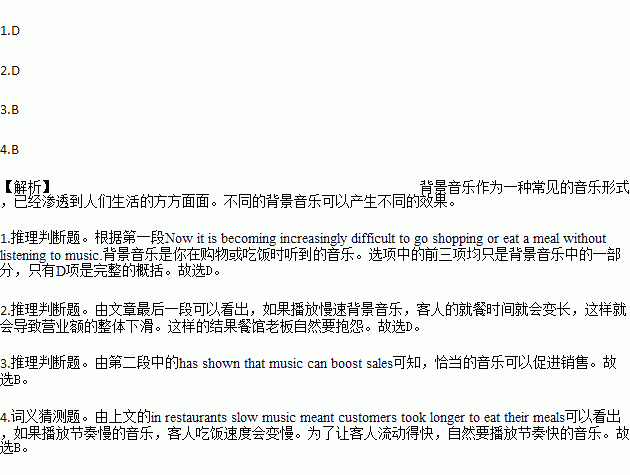题目内容
Background music may seem harmless, but it can have a powerful effect on those who hear it. Recorded background music first found its way into factories, shops and restaurants in the US. But it soon spread to other parts of the world. Now it is becoming increasingly difficult to go shopping or eat a meal without listening to music.
To begin with, “muzak” (音乐广播网) was intended simply to create a soothing (安慰) atmosphere. Recently, however,it has become big business—thanks in part to recent research. Dr. Ronald Milliman, an American marketing expert,has shown that music can boost sales or increase factory production by as much as a third.
However, it has to be light music. A fast one has no effect at all on sales. Slow music can increase receipts by 38%. This is probably because shoppers slow down and have more opportunity to spot items they like to buy. Yet, slow music isn't always the answer. Dr. Milliman found, for example, that in restaurants slow music meant customers took longer to eat their meals, which reduced overall sales. So restaurant owners might be well advised to play uptempo_music to keep the customers moving—unless of course, the resulting indigestion (消化不良) leads to complaints!
1.Background music means ________.
A. light music that customers enjoy most
B. fast music that makes people move fast
C. slow music that can make customers enjoy their meals
D. the music you are listening to while you are doing something
2.Restaurant owners complain about slow music because ________.
A. it results in indigestion
B. it increases their sales
C. it keeps customers moving
D. it decreases their sales
3.We can know from the text that ________.
A. background music was first used in big department stores
B. proper music can increase the selling of goods
C. light music has a bad effect on production
D. restaurant owners had better play slow music to comfort their customers
4.The underlined expression “uptempo music” probably means ________.
A. slow music B. fast music
C. light music D. classical music
 阅读快车系列答案
阅读快车系列答案
